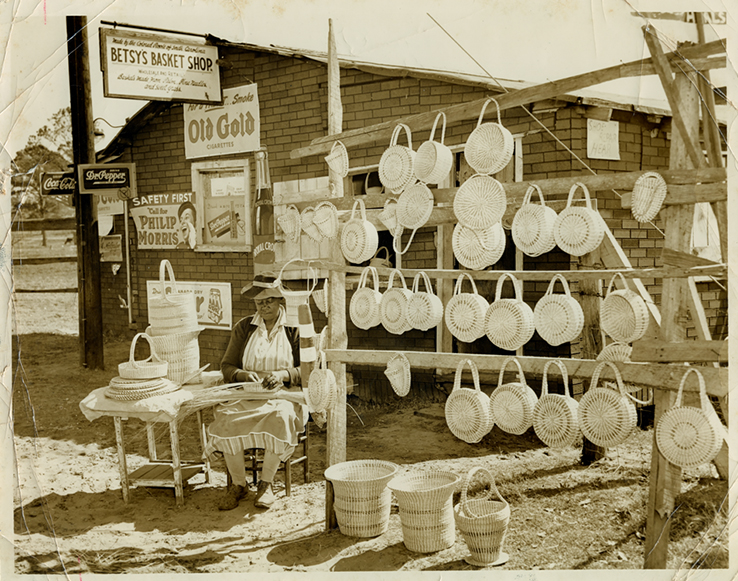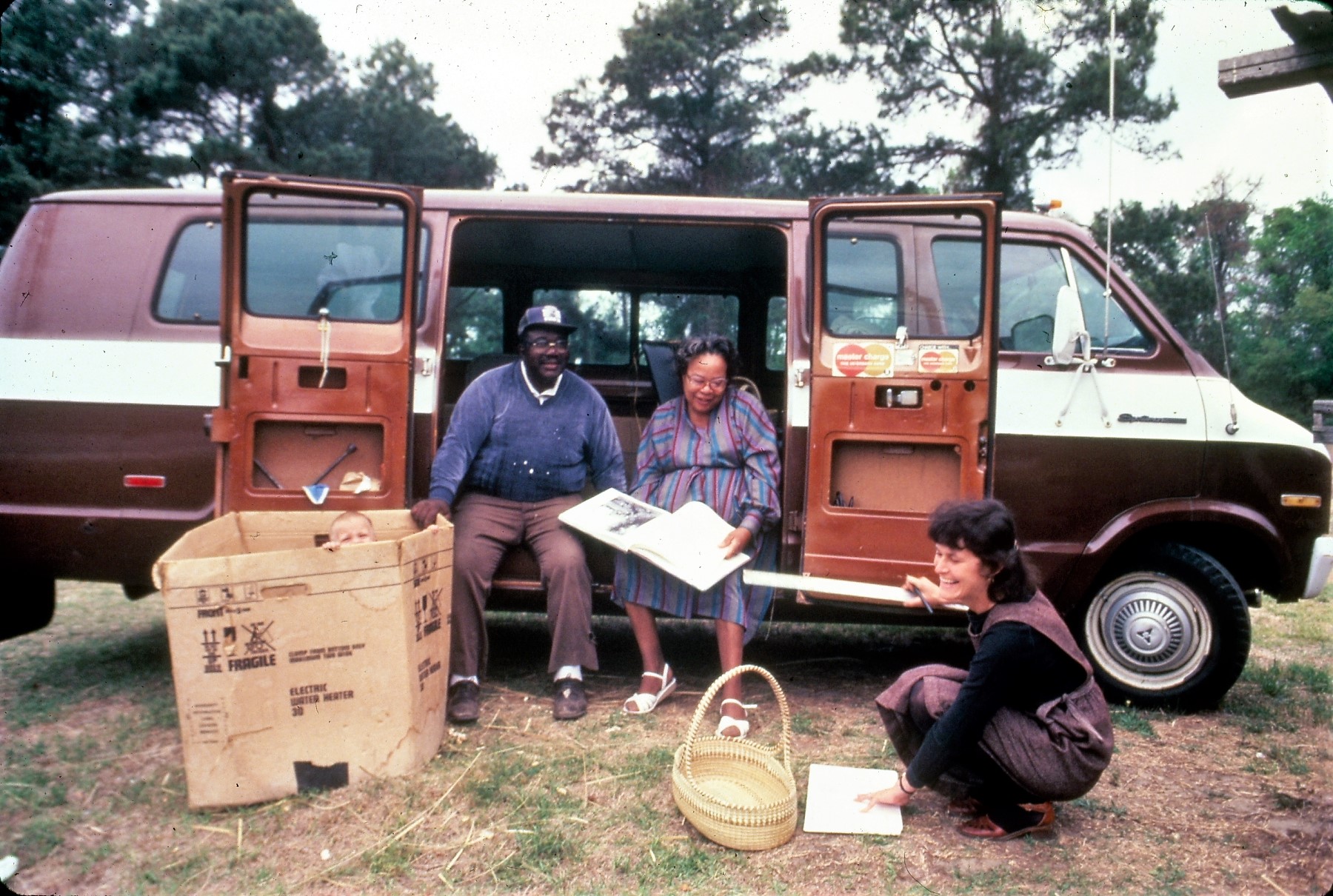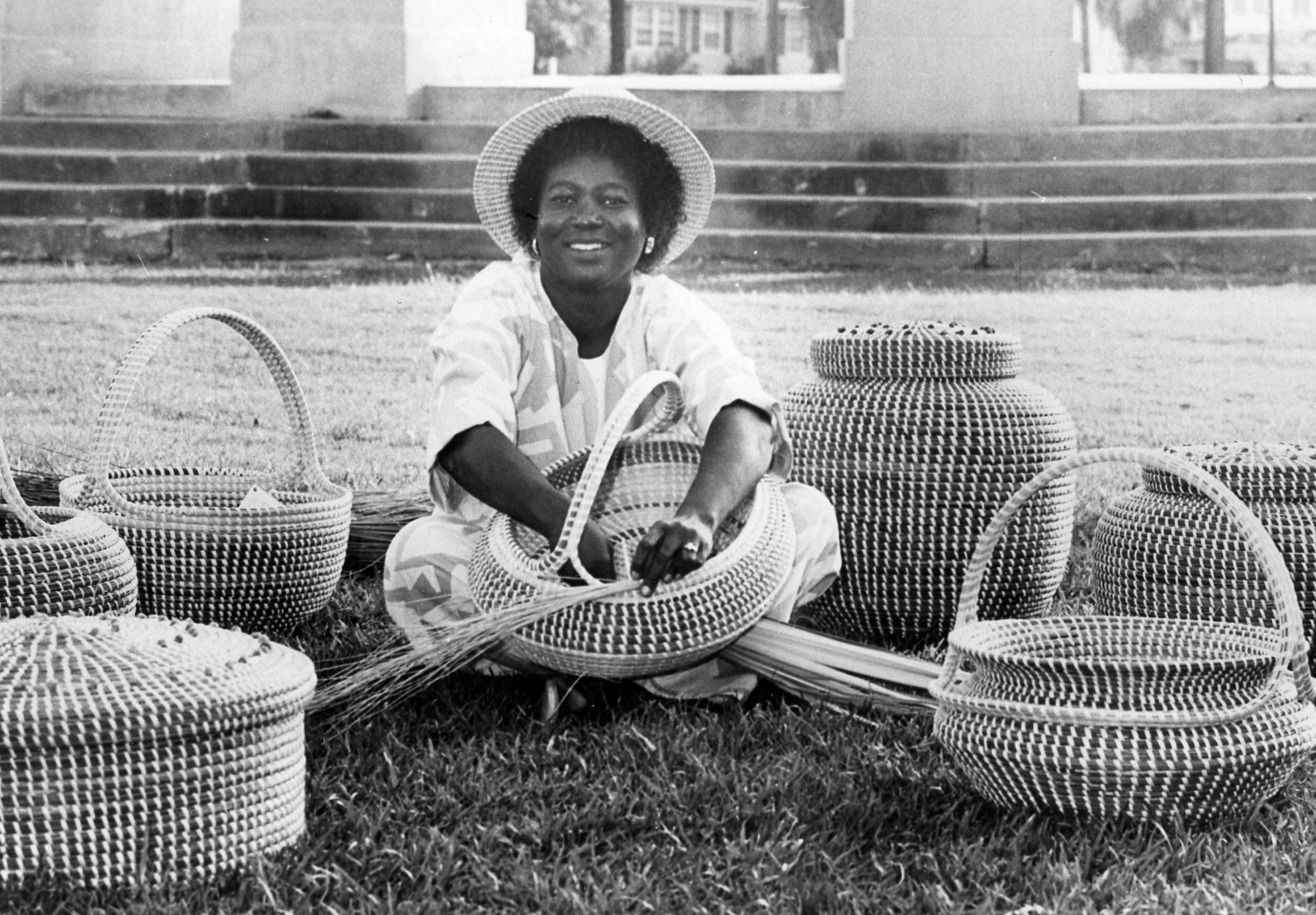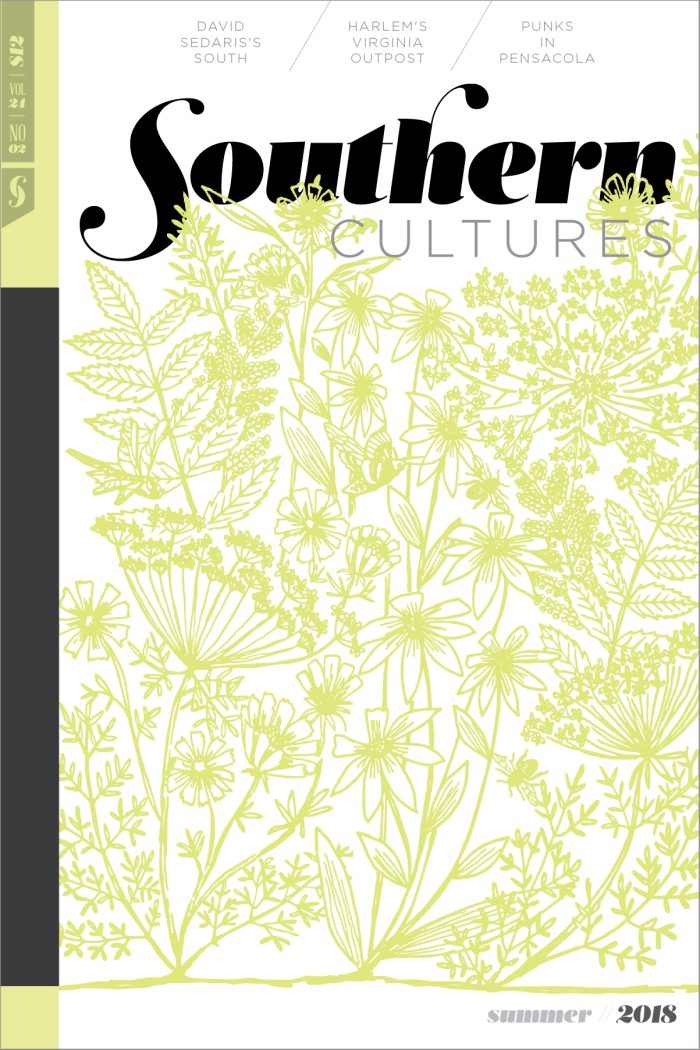This essay is excerpted from a longer piece in the Summer 2018 issue. To read the essay in full, visit Project MUSE.
Anyone who travels along Highway 17 North or visits Charleston’s downtown market cannot fail to notice the unique local art sold on the side of the road in Mount Pleasant and on street corners in the city. Sweetgrass baskets have become the most prestigious and sought-after emblem of African American culture in South Carolina, and they constitute a tangible piece of history tourists admire and want to take home.
Basket makers have come a long way since their ancestors arrived on these shores. The plight of enslaved Africans, brought in captivity to the colony of Carolina, forced to labor on Lowcountry rice plantations and to make baskets to prepare the crop for market, is poignantly expressed in Bob Marley’s rendering of Psalm 137, “By the Rivers of Babylon.” Yet, as we move into the twenty-first century, another reggae song’s lyrics may be more apropos: Babylon is falling. The colonial hierarchies and coercive practices that relegated African Americans to a fixed place at the bottom of the social ladder, to work as servants and manual laborers, have been challenged, and the once denigrated Gullah culture has begun to draw attention, and protection, from friends in high places.
“Gullah,” and the more recent composite “Gullah/Geechee,” are identities now widely embraced by people of African descent whose forebears came to the Low-country, beginning in the late seventeenth century, with the first waves of European colonists. In 2006, the South Atlantic coast from Wilmington, North Carolina, to Jacksonville, Florida (since extended to St. Augustine), was designated the Gullah/Geechee Cultural Heritage Corridor and placed under the authority of the National Park Service—the same year that sweetgrass basketry was declared the state craft of South Carolina and a stretch of roadway heading north from the Cooper River Bridge was named the Sweetgrass Basket Makers Highway. Like many state mandates, these tokens of recognition come late in the day and are largely unfunded, but slowly the Heritage Corridor is emerging as a series of historical sites dedicated to interpreting Lowcountry African American culture. Ironically, just as the highway department posted billboards naming the stretch of road with the majority of stands for the sweetgrass makers, it widened the highway to six lanes, separated the asphalt from the shoulder by a concrete curb and sidewalk, and increased the speed of traffic, making the stands much harder to access by travelers zooming past.1

Stretching along the tidewater regions of four states, the Heritage Corridor coincides precisely with the range of the Lowcountry rice kingdom. There, for most of the eighteenth and nineteenth centuries, enslaved people of African descent using indigenous grasses, rush, and other plant materials sewed fanner baskets for processing rice, the export crop that made South Carolina the wealthiest colony and state in North America. A hundred years ago, when commercial rice production in the Lowcountry ceased and the bulrush work basket fell out of use, decorative household forms made from sweetgrass became a viable source of income for cash-poor farm families near the village of Mount Pleasant. By 1930, basket sewers—coiled baskets are “sewn,” rather than “woven”—found a way to reach a moving market. They began selling baskets on the side of Highway 17 (then Route 40), the main North-South artery carrying tourist traffic between Florida and the Northeast.
Today, Lowcountry baskets enjoy international recognition as a collectible form of art whose finest examples are prized by curators and connoisseurs. The inventiveness and skill level of the basket makers have never been higher. In 2008, Mary Foreman Jackson, the tradition’s foremost practitioner, won a MacArthur Fellowship for her outstanding work, making her, in the words of another basket maker, “a half a millionaire.” She has dined with Prince Charles and met the Empress of Japan. And, in 2016, the Gibbes Museum of Art in Charleston named its newly renovated contemporary art space the Mary Jackson Modern and Contemporary Gallery—publicly proclaiming Lowcountry basketry as the region’s premier living art. Yet, at this very moment when Gullah culture has become fashionable, and its preeminent symbol—the sweetgrass basket—has reached an apex of artistry, its makers are confronting challenges that endanger the future of the craft.2
In the 1980s, when I began interviewing basket makers for McKissick Museum’s Lowcountry Basket Project, the number one problem sewers cited was the dwindling supply of sweetgrass (Muhlenbergia sericea, syn. M. filipes, M. capillarisvar. filipes). As more and more of the coastline was acquired by developers and turned into resorts and gated communities, access to the plant’s natural habitat was increasingly cut off. By the time the exhibition Grass Roots: African Origins of an American Art opened in 2008, more ominous threats were looming: the economic recession which began that year, coupled with the impact of Highway 17’s widening on basket stands, depressed basket sales, forcing makers to relocate their stands and find new ways to reach their clientele. Even more serious, the proliferation of residential developments and shopping centers was pushing basket makers off the land their forebears, the “Old People,” acquired in the wake of the Civil War. The makeover of the landscape from a patchwork of rural black settlements to a densely populated, majority-white suburb has squeezed African American family enclaves between upscale subdivisions and commuter condos.3

Another challenge basket makers face, which they share with traditional artists across America and around the world, is the struggle to pass their skills and dedication to the next generation. While folklorists observe the changing arc of a living tradition and see reasons for optimism, sewers perennially complain about the difficulty of motivating young people to pursue an activity that may appear tedious and unrewarding. “It’s really a dying art,” one basket maker reported in 2007. “You’ll see a bunch of baskets, but the older people are doing them, not the younger generation . . . [T]he new generation, they don’t want to make baskets.” Wooed by opportunities and temptations their parents and grandparents never had and forced to make a living in the modern economy, the daughters of lifelong basket makers are more likely to set up websites for their mothers than to continue making baskets themselves.4
Prospects for the survival of the basket stands are not bright. The earliest images of highway basket stands discovered to date are a series of four photographs taken at the intersection of Hamlin Road and Highway 17 in 1938 by Blu-ford Muir, a land scout for the USDA National Forest. Highway 17 North was a two-lane road overhung by live oaks, with not a single traffic signal for fifty miles from the Santee River south to the Cooper River Bridge, and it remained that way until the late 1970s, when increased traffic made widening the road to four lanes a matter of public safety. It was still easy, however, to spot a stand at the edge of the highway and pull off onto the grassy shoulder. After the debris from Hurricane Hugo was cleared away in 1989, residential and commercial construction surged, increasing pressure on the existing infrastructure. Mount Pleasant’s population more than doubled over the next two decades, expanding the potential clientele for basket makers but irrevocably altering the demographics of the area. Almost all the newcomers were white, driving the proportion of African Americans in the population down from 15.7 percent in 1990 to 7.3 percent ten years later.5
Since 2009, when construction began on a project to widen a five-mile stretch of Highway 17, the basket stands have been under siege. The plan was bound to be disruptive: it involved widening the road from four to six lanes and building medians, a curb and gutter drainage system, and concrete sidewalks along a stretch of the highway that supported sixty-three stands. A “no-build alternative” described in the Environmental Assessment was never really put on the table. Only a single group, the Gullah/Geechee Nation and Sea Island Coalition, publicly proposed the radical option of limiting growth through zoning, rather than expanding the infrastructure.6
Sensing the potential for ecological disaster, town and highway administrators asked SCAFA and the National Park Service’s Charles Pinckney Historic Site—notably Community Partnership Specialist Michael Allen—to consult with the basket makers and suggest ways to mitigate the inevitable impacts of the highway widening. The project team held public meetings and solicited input from residents and business owners. Staff working for Tidewater Environmental Services walked the highway, sought out the “owners” of all stands within the project zone, and interviewed thirty-five basket makers, some who had been at their present locations two, five, or ten years, and many who had been there for thirty, forty, even sixty years. There was almost unanimous consensus about one thing: remaining on Highway 17 was “extremely important.”7

The outreach process won an “Exemplary Human Environment Initiative Award” from the Federal Highway Administration in recognition of efforts above and “beyond regulations to minimize the impact to the sweetgrass basket makers.” The Department of Transportation proved flexible in permitting basket makers to occupy the highway right of way. New stands were situated as close to the old locations as possible. Additional curb cuts were authorized if stand owners asked for them. The Town of Mount Pleasant turned a blind eye to any signage the basket makers put up. Moreover, the Highway Department offered tax incentives to roadside businesses that provided space for a basket stand: $15,000 deducted from its impact fees for transport for one stand, $30,000 deducted for two.8
No matter how well intentioned the mitigation efforts were, in the end they amounted to mere palliatives. As road-building progressed, it became clear the majority of stands would have to be moved and replaced. A new modular unit designed by Collins Engineering and built by highway workers using pressure-treated lumber, stainless steel screws, galvanized bolts and twist straps, and metal roofing was engineered so that it could be lifted and set down with a fork lift, in case it needed to be transported to a temporary location while roadwork was underway. Some basket makers welcomed the sturdy new structures and appreciated the skilled labor of the highway construction workers who built them. A few sewers have customized their stands, adding display space, windbreaks, and new signage. Many have abandoned the modular units and built old-fashioned, handmade racks further north, on stretches of road where travelers can pull off with ease.9
When construction came to an end in spring 2013, basket makers sitting in their stands looked out on a vastly altered landscape—six lanes of traffic bordered by a high, wide sidewalk and divided by a raised median. Old Babylon may indeed be falling, but new Babylon is rising with appalling speed in front of our eyes. The pristine salt marshes and national forests of the South Carolina Lowcountry are rapidly giving way to an industrial behemoth, attracting the likes of Boeing, BMW, Blackbaud, and Volvo. These corporations bring the promise of jobs—along with environmental threats to fragile eco-systems. While laws that once curbed educational and employment opportunities for black people have been struck from the books, and the ceiling on advancement in the workplace is rising for many, new global realities are altering the physical, social, and economic environment. Foreign economies compete with local producers; real estate development and the rising sea threaten the plant materials used in basketry; and access to other occupations and lifestyles draws young people away from traditional pastimes. Besides the aesthetics of the basket—its marvelous geometry, the earthy colors of the grasses, the water-tight stitching, the mix of subtlety and sophistication of form—can its role as a vessel of history and heritage, an idea as well as an object, be “sold” to an audience broad enough to insure its survival?
As globalization and the Web link our worlds, and as trends in fashion, design, and music cross social boundaries, the sweetgrass basket in all its iterations retains its power as a local symbol of individual identity and cultural distinction. Making baskets is a meditative act, a form of labor and a collective process that strengthens families and links generations. Basket makers have always known who they are and where they come from. In this era, they know they are artists too. While each sewer pursues her or his art out of personal necessity, all feel a shared sense of guardianship of the region, and a debt to a tradition sanctioned by their ancestors.
This essay is excerpted from a longer piece in the Summer 2018 issue (vol. 24, no.2). To read the essay in full, visit Project Muse.
As guest curator for McKissick Museum at the University of South Carolina, Dale Rosengarten developed the groundbreaking exhibition and catalog Row Upon Row: Sea Grass Baskets of the South Carolina Lowcountry (1986). Her dissertation (Harvard University, 1997) placed the Lowcountry basket in a global setting and led to a partnership with the Museum for African Art in New York. With co-curator Enid Schildkrout, Dale produced the exhibit Grass Roots: African Origins of an American Art, which opened in 2008 at the Gibbes Museum of Art in Charleston and ended its national tour in 2010 at the Smithsonian Institution in Washington, DC.NOTES
- The origins of the term “Gullah” are open to debate. Some historians trace it to the Gola people of the Upper Guinea Coast, but there is a broader consensus that ties it to “Angola,” a region that accounted for around 40 percent of the deportees sold into slavery in Charleston. Geechee seems to be derived from the Ogeechee River in Georgia, and it is used in a variety of ways, sometimes but not always synonymous with Gullah. First applied to the creole language Africans on both sides of the Atlantic created during the centuries of the slave trade, Gullah now describes all aspects of the culture, including the coiled grass basket tradition for which the Lowcountry is famous. For more on the Gullah/Geechee Cultural Heritage Corridor, see “A Unique African American Culture,” National Park Service, accessed January 6, 2013, http://www.nps.gov/guge/index.htm; see also Gullah Geechee Cultural Heritage Corridor Management Plan, prepared and published by the National Park Service, Denver Service Center, 2012.
- For more on Mary Jackson’s recent accolades, see “Mary Jackson,” MacArthur Fellows Program, MacArthur Foundation, accessed March 2, 2018, https://www.macfound.org/fellows/800/; “A Lowcountry Legend: Mary Jackson,” Garden & Gun, April/May 2016, accessed March 2, 2018, http://gardenandgun.com/feature/a-lowcountry-legend-mary-jackson/; “Mary Jackson,” The Gibbes Museum of Art, accessed March 2, 2018, http://www.gibbesmuseum.org/programs-events/visiting-artist/mary-jackson/18.
- For botanical information on sweetgrass, see Robert J. Dufault, Stalking the Wild Sweetgrass: Domestication and Horticulture of the Grass Used in African American Coiled Basketry (New York: Springer, 2013), 83–86; D. J. Gustafson and P. M. Peterson, “Reexamination of Muhlenbergia capillaris, M. expansa, and M. sericea (Poaceae: Muhlenbergiinae), Journal of the Botanical Research Institute of Texas 1 (2007): 85–89; for excerpts from interviews recorded during the Lowcountry Basket Project, see “Row Upon Row: Sea Grass Baskets of the S.C. Lowcountry,” Knowitall.org, accessed April 4, 2018, https://www.knowitall.org/collections/row-upon-row-sea-grass-baskets-sc-lowcountry.
- For a deep analysis of the “practical, aesthetic, economic, therapeutic, spiritual, and political functions” of baskets and basketmaking, and strategies folklorists can adopt for transforming the circumstances of production, public appreciation of the art, and the health and well-being of the culture at large, see William Westerman, “Wild Grasses and New Arks: Transformative Potential in Applied and Public Folklore,” Journal of American Folklore 119, no. 471 (2006): 111–28. For the comment about “a dying art,” see interview with basket maker, Charleston, SC, March 8, 2007, quoted in Brian Charles Grabbatin, “Sweetgrass Basketry: The Political Ecology of an African American Art in the South Carolina Lowcountry” (master’s thesis, College of Charleston, 2008), 57. For a narrative description of the economic opportunities available to black women in the Lowcountry in the early decades of the twentieth century, see Kate Porter Young, “Mary Jane Manigault: A Basket Maker’s Legacy,” in South Carolina Women: Their Lives and Times vol. 3, eds. Marjorie Julian Spruill, Valinda W. Littlefield, and Joan Marie Johnson (Athens: University of Georgia Press, 2012), 307–21, esp. 309–12; a Google search for “sweetgrass baskets” yields at least two dozen websites, including Facebook pages, advertising baskets for sale. Mae Hall discusses the origins of her website in Grass Roots: The Enduring Art of the Lowcountry Basket, a video by Dana Sardet, Center for the Documentary, College of Charleston, 2008. See also Grabbatin, Sweetgrass Basketry, 32.
- Patrick T. Hurley, Brian Grabbatin, Cari Goetcheus, and Angela Halfacre, “Gathering, Buying, and Growing Sweetgrass (Muhlenbergia sericea): Urbanization and Social Networking in the Sweetgrass Basket-Making Industry of Lowcountry South Carolina,” African Ethno-botany in the Americas, eds. Robert Voeks and John Rashford (New York: Springer Science+Business Media, 2013), 157–58. Mount Pleasant’s population escalated from some 30,000 residents in 1990, to 48,000 in 2000, to 68,000 in 2010, to upwards of 80,000 in 2016; the number is projected to top 100,000 in 2020. For demographic data, see “Population of Mount Pleasant, SC,” Population.us, accessed January 5, 2013, http://population.us/sc/mount-pleasant/, and “Mount Pleasant, South Carolina,” Wikipedia, January 5, 2013, http://en.wikipedia.org/wiki/Mount_Pleasant,_South_Carolina#Demographics; David Slade, “Bursting at the Seams,” Post and Courier, May 18, 2016, accessed March 2, 2018, https://www.postandcourier.com/archives/bursting-at-the-seams/article_99142793-58ca-5497-89d2-bb8c1dc7ef1f.html.
- Catherine F. Marshall, “Sweetgrass Basket Stands under Siege,” Chrestomathy: Annual Review of Undergraduate Research 12 (2013); “U.S. Route 17 Road Improvements from the Isle of Palms Connector (SC 517) to Darrell Creek Trail in Mount Pleasant, South Carolina,” Environmental Assessment, July 2009, 3-1, 5-6; Richey and Young, Cultural Resource Survey, iii.
- Blair Goodman, Tidewater Environmental Services, Charleston, SC, November 15, 2012, interview by Catherine F. Marshall and D. Rosengarten; U.S. 17 Road Widening Sweetgrass Basket Maker Interviews Preliminary Findings, Appendix B and C.
- “Highway 17 Widening Project Wins FHWA Environmental Award,” n.p. [4]; Stokes-Marshall, October 24, 2012.
- Goodman, November 15, 2012; “Basket Stand Detail,” Collins Engineering, June 2010.


